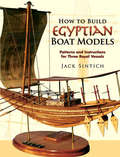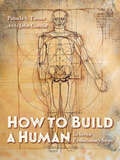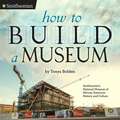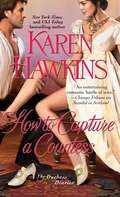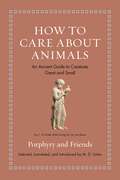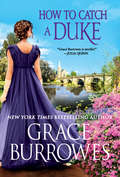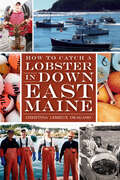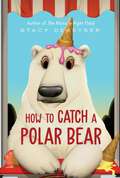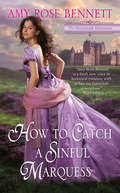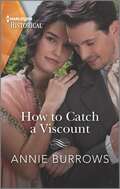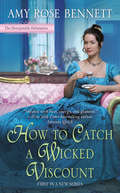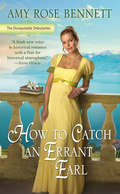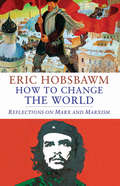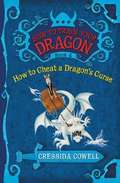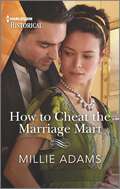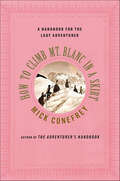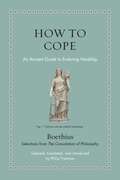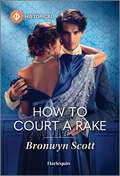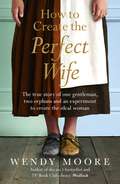- Table View
- List View
How to Build Egyptian Boat Models: Patterns and Instructions for Three Royal Vessels
by Jack SintichThe ancient Egyptians were avid model makers. Many of their miniature masterpieces were replicas of boats, lovingly handcrafted from the finest woods and often decorated with rich materials such as ivory. Amazing examples of Egyptian maritime art and technology, many of these models remain intact today, displayed and admired in museums and private collections centuries after they were masterfully crafted.Concise, authoritative, and easy to follow, this unique guide shows modern shipwrights how to build three ancient Egyptian boat models following the same expert techniques used by craftsmen thousands of years ago. A beginner's skill level is all that's needed to expertly construct the royal sailing ships of King Khufu (ruled ca. 2551-2528 B.C.), Queen Hatshepsut (ruled ca. 1479-1458 B.C.) and the great Ramses II (ruled ca. 1279-1213 B.C.). Learn how to select the proper wood and gather the appropriate tools and materials. Follow simple guidelines for every aspect of construction, from hull to sails to rowing oars--even building the display stand. Replicate the paints and colors used for the original Egyptian models. And discover ancient free-hand painting techniques, including how to create authentic hieroglyphic symbols to decorate your project. A profusion of detailed patterns and diagrams--plus photographs of each finished model--accompany the text, guiding crafters step-by-step to shipbuilding success.
How to Build Stonehenge
by Mike PittsDrawing on a lifetime’s study and a decade of new research, archaeologist Mike Pitts explores the mystery of how Stonehenge was built. There is nothing like Stonehenge: the simple, graphic genius of these great, arranged blocks. The stones seem to rise from the ground in some antediluvian heave of the Earth: lintels, great horizontal slabs, roughly squared, the grey rock now covered in subtle lichen green. But who made it? When did they make it? And most importantly, how was it built? How it was constructed is perhaps the central question about Stonehenge and likely the most common query from its many visitors. Yet it’s one of the least-researched aspects of the site, which author Mike Pitts aims to correct in this new book. With a unique focus on the monument itself, How to Build Stonehenge describes the site as it is today, what we know about the different types of stone, how they were carved and positioned to create the ultimate in megalithic architecture, and how this was taken down and left to ruin until the decay was arrested in the twentieth century with substantial restoration works. Pitts then examines the latest research on the site, interrogating the key questions: the sources of the various stones, how they were transported, and how it was all put together. The book considers the first significant study of sarsen, the stone most of Stonehenge is made of, in detail. Recent groundbreaking discoveries using cutting-edge scientific techniques have given us incredible new detail on the sources of these immense stones and brings it into the wider context of other megalith buildings around the world, as well as placing Stonehenge at the center of a network of European Bronze Age cultures.
How to Build Wooden Boats: With 16 Small-Boat Designs
by Edwin MonkWritten especially for the amateur boat builder, this concise guidebook contains clear, practical directions and designs for building 16 modern small boats, rowboats, sailboats, outboards, a 125-class hydroplane, and a runabout. You'll find detailed step-by-step instructions, with diagrams, for each design presented. The construction techniques have been kept as simple as possible; moreover, the standardized techniques described and illustrated here are used in boat yards and can be used to construct a variety of other craft not included in this volume.After an enlightening general discussion of small boat building, Mr. Monk, a noted naval architect, presents detailed guidelines for selecting a design, choosing and assembling building materials, and building and finishing the craft. Boat builders can choose from these basic designs: nine-foot dinghy, eight-foot punt, two skiffs, two outboard boats for camping and fishing enthusiasts, two outboard runabouts, an outboard cruiser, outboard racer, racing hydroplane, 18-foot runabout, simplified sailer, centerboard sloop, racing sailboat, and keel sloop.With this book at your fingertips, you can experience the satisfaction of building and using a strong, well-proportioned craft, designed by an expert — a boat that offers hours of enjoyment, both in the workshop and on the water.
How to Build a Human: In Seven Evolutionary Steps
by Pamela S. TurnerThe epic story of our evolution in seven big steps!How did we become who we are? With trademark wit, acclaimed science writer Pamela S. Turner breaks down human evolution into the seven most important steps leading to Homo sapiens. How, when, and why did we:1. stand up,2. smash rocks,3. get swelled heads,4. take a hike,5. invent barbecue,6. start talking (and never shut up), and 7. become storytellers?This fascinating, wickedly funny account of our evolutionary journey turns science into an irresistible story. Vetted by experts at the Smithsonian's Human Origins Program, the book also features incredibly detailed portraits by celebrated paleo-artist John Gurche that bring our early ancestors to life.
How to Build a Museum: Smithsonian's National Museum of African American History and Culture
by Tonya BoldenSmithsonian's National Museum of African American History and Culture is truly groundbreaking! The first national museum whose mission is to illuminate for all people, the rich, diverse, complicated, and important experiences and contributions of African Americans in America is opening.And the history of NMAAHC--the last museum to be built on the National Mall--is the history of America. The campaign to set up a museum honoring black citizens is nearly 100 years old; building the museum itelf and assembling its incredibly far-reaching collections is a modern story that involves all kinds of people, from educators and activists, to politicians, architects, curators, construction workers, and ordinary Americans who donated cherished belongings to be included in NMAAHC's thematically-organized exhibits. Award-winning author Tonya Bolden has written a fascinating chronicle of how all of these ideas, ambitions, and actual objects came together in one incredible museum. Includes behind-the-scenes photos of literally "how to build a museum" that holds everything from an entire segregated railroad car to a tiny West African amulet worn to ward off slave traders.
How to Build an Aircraft Carrier: The incredible story behind HMS Queen Elizabeth, the 60,000 ton star of BBC2’s THE WARSHIP
by Chris TerrillDiscover the enthralling story of the HMS Queen Elizabeth, the Royal Navy's largest ever aircraft carrier and SUBJECT OF THE MAJOR NEW BBC DOCUMENTARY SERIES THE WARSHIP'Fascinating, often funny and sometimes moving . . . Terrill takes us deep into the bowels of Britain's biggest warship . . . Exhilarating' THE TIMES________65,000 tons. 280 metres long. A flight deck the size of sixty tennis courts. A giant piece of Sovereign British territory that's home to up to 50 Aircraft. HMS Queen Elizabeth is the biggest ship in the Royal Navy's history and one of the most ambitious and exacting engineering projects ever undertaken in the UK.But it's her ship's company of 700, alongside an air group of 900 air and ground crew that are Big Lizzie's beating heart. And How to Build an Aircraft Carrier tells their story.From before the first steel of her hull was cut, Chris Terrill has enjoyed unprecedented access to Queen Elizabeth and the men and women who have brought her to life. From Jerry Kyd, the ship's inspirational Captain to Lt Cdr Nathan Grey, the first pilot to land Britain's new stealth jet fighter on her deck, Terrill has won the trust and confidence of the ship's people.How to Build an Aircraft Carrier tells the story of Britain at its best: innovative, confident, outward-looking and world beating.________'A detailed account of the challenges, trials and triumphs on the ship's progression . . . and a portrait of the men and women who made it happen. [Terrill] writes with affection, humour and understanding' TELEGRAPH
How to Capture a Countess: Duchess Diaries 1 (The Duchess Diaries #1)
by Karen HawkinsNew York Times bestselling author Karen Hawkins sets Scottish hearts afire in this delightfully witty and sexy Regency romance, the first in her Duchess Diaries series.Urged by her favorite nephew, the intimidating Duchess of Roxburghe agrees to transform a thorny Scottish rose into a lovely bloom. But even she isn’t prepared for fiery Rose Balfour.At seventeen, Rose fell wildly in love with Lord Alton Sinclair, known as Lord Sin for his wicked ways. Stung by his indifference, the starry-eyed girl tried to win an illicit kiss, but then panicked and pushed the notorious rakehell into a fountain. Leaving Lord Sin floating among the lily pads to the mocking laughter of his peers, Rose escaped back to the obscurity of the Scottish countryside.Six years later, Sin convinces his aunt, the Duchess of Roxburghe, to invite Rose to her annual house party, where he plans to get revenge by making Rose the laughingstock of polite society. To his astonishment, he finds she has become an alluring woman who threatens to turn the tables on his nefarious plans. Thus Sin and Rose begin an epic battle of the sexes that becomes more passionate at every turn. Eventually, one will have to surrender…but to vengeance? Or to love’s deepest passion?
How to Care about Animals: An Ancient Guide to Creatures Great and Small (Ancient Wisdom for Modern Readers)
by M. D. UsherAn entertaining and enlightening anthology of classical Greek and Roman writings on animals—and our vital relationships with themHow to Care about Animals is a fascinating menagerie of passages from classical literature about animals and the lives we share with them. Drawing on ancient writers from Aesop to Ovid, classicist and farmer M. D. Usher has gathered a healthy litter of selections that reveal some of the ways Greeks and Romans thought about everything from lions, bears, and wolves to birds, octopuses, and snails—and that might inspire us to rethink our own relationships with our fellow creatures. Presented in lively new translations, with the original texts on facing pages, these pieces are filled with surprises—anticipating but also offering new perspectives on many of our current feelings and ideas about animals.Here, Porphyry makes a compelling argument for vegetarianism and asserts that the just treatment of animals makes us better people; Pliny the Elder praises the virtuosity of songbirds and the virtuousness of elephants; Plutarch has one of Circe’s pigs from the Odyssey make a serio-comic case for the dignity of the beasts of the field; Aristotle puts the study of animals on par with anthropology; we read timeless Aesopian fables, including “The Hen That Laid the Golden Egg” and “The Fox and the Grapes”; and there is much, much more.A Noah’s Ark of a book, How to Care about Animals is guaranteed to charm and inspire anyone who loves animals.
How to Catch a Bogle (How to Catch a Bogle #1)
by Catherine JinksMany orphans in Victorian England must resort to begging—but Birdie is busy catching monsters… If ever a chill entered her soul, or the hope suddenly drained from her heart, she knew a bogle was to blame… Birdie McAdam, a ten-year-old orphan, is tougher than she looks. She's proud of her job as apprentice to Alfred the Bogler, a man who catches monsters for a living. Birdie lures the bogles out of their lairs with her sweet songs—and Alfred kills them before they kill her. On the mean streets of Victorian England, hunting bogles is actually less dangerous work than mudlarking for scraps along the vile river Thames. Or so it seems, until the orphans of London start to disappear… This historical fantasy for young readers features an &“action-packed story and likable characters&” along with a heroine to cheer for (School Library Journal). &“Pitch-perfect.&”—Booklist (starred review)
How to Catch a Duke (Rogues to Riches #6)
by Grace BurrowesA fake engagement and plenty of charm keep the pages turning in this delightful Regency romance which the USA Today bestselling author Julia Quinn hails as "terrific.""I have come to ask you to kill me, my lord."Miss Abigail Abbott desperately needs to disappear—permanently—and the only person she trusts to help her do that is Lord Stephen Wentworth, heir to the Duke of Walden. Stephen is brilliant, charming, and—when he needs to be—absolutely ruthless. So ruthless that he proposes marriage instead of "murder" to keep Abigail safe.Stephen was smitten the instant his sister introduced him to Abigail, a woman with the dignity and determination of a duchess and the courage of a lioness. When she accepts his courtship of convenience, he also discovers she kisses like his most intimate wish come true. For Abigail, their arrangement is a sham to escape her dangerous enemies. For Stephen, it's his one chance to share a lifetime with the lady of his dreams—if only he can convince her his love is real.
How to Catch a Lobster in Downeast Maine (American Palate Ser.)
by Christina Lemieux OragonaAn insider&’s look at the daily lives of Maine&’s lobster fishermen.What is it like to live and work in a lobster fishing village in one of the most remote parts of Maine? The extreme weather conditions of the Maine coast, unreliable fishing seasons and an ever-present element of danger are just a few of the challenges encountered by lobster fishermen. They must adapt to constant change and balance exploiting the natural resource for personal profit with a duty to conserve lobster stocks for future generations. Despite the challenges, most would not trade the benefits of their job—from the independence it offers to unique pastimes like lobster boat racing. These fishermen aren&’t just the masters of their ships, they are the captains of their souls. From a family of four generations of lobster fishermen, Christina Lemieux Oragano provides a glimpse inside these lobstering communities and celebrates it for those lucky enough to live it—the trials, triumphs and even a few of her favorite lobster recipes.&“Her first book is a comprehensive, authentic, and honest insider&’s look at the life of a Maine lobsterman. The book covers the strategy involved (they don&’t just plunk those traps anywhere), the complexities of the market, the perils of the profession, the finer points of lobster-boat design, and even the unwritten rules that lobstermen use to police their waters (they are strictly, if unofficially, enforced).&” —Colby Magazine&“With an abundance of romanticized and dramatic fishing stories on the shelves, Christina wanted to tell the story in an accurate way and felt a responsibility not just to the fishermen but to her family also.&” —Machias Valley Observer &“Christina lived in Cutler, worked in the industry and then interviewed a number of people to make this book possible. My first question for her is when will the next book come out?&” —Maine Coastal News
How to Catch a Polar Bear (Washington Park Stories)
by Stacy DeKeyserIn this &“funny and heartwarming&” (Booklist) historical fiction companion to The Rhino in Right Field, Nick&’s summer gets way more exciting when a polar bear escapes from the local zoo—perfect for fans of Stuart Gibbs and The One and Only Ivan.It&’s 1948, and twelve-year-old Nick is ready for the best summer ever. He&’s going to hang out with his best pal, Ace, and maybe with Penny too—she is a girl, but she has a great throwing arm. Then things get wild when a polar bear escapes from Milwaukee&’s city zoo and appears right on his block. They&’re all going to have to keep their eyes open now. But Nick&’s grand plans start to crumble when Ace gets a paper route and Penny decides to share it with him. Now they&’re never around. Nick himself is working at his Uncle Spiro&’s frozen custard shop, but at least he gets free all-you-can-eat dessert. When Uncle Spiro opens a custard stand at the zoo, Nick volunteers to help—if that polar bear escapes again, he&’ll have a front row seat! But their competitor, Happy Harold, opens a stand of his own right outside the zoo. Now Nick is scrambling to keep their customers, especially because Happy keeps playing dirty tricks. When Penny discovers that someone may have let the polar bear out on purpose, Nick suspects that Happy might be involved. With mysteries to solve and a whole zoo-full of monkey business, it looks like Nick&’s summer won&’t be so boring after all!
How to Catch a Sinful Marquess (The Disreputable Debutantes #3)
by Amy Rose BennettA reserved debutante and a former soldier make an unlikely but fated match as they hasten for the Isle of Skye. Orphaned heiress Olivia de Vere should have the world--or at least the men of the ton--at her feet. But when she's thrown out of a young ladies' academy, Olivia doubts she'll ever find someone who will love her, rather than her bank account. To make matters worse, her dissolute cousin Felix is determined to marry her against her wishes. A virtual prisoner in her guardians' London townhouse, Olivia can&’t help but develop a tendre for her neighbor, a handsome Scottish marquess. Battle-scarred in more ways than one, Hamish MacQueen, Lord Sleat, has braved many dangers in life. But nothing has quite prepared him for the shock of having a young child dumped on his doorstep, with a note claiming she&’s his daughter. Just in the nick of time his pretty neighbor appears, offering to act as a nursemaid for the young girl on their journey to his estate in Scotland. He suspects she has her own reasons for wanting to flee the country… The close traveling quarters leads to a fierce attraction between Olivia and Hamish that seems impossible to resist. But when ghosts from the past and monsters from the present threaten to tear them apart, will their unlikely love survive?
How to Catch a Viscount (The Patterdale Siblings #2)
by Annie BurrowsA sparky mistaken-identity Regency romance! Her plan to marry well…Has backfired spectacularly! Miss Betsy Fairfax must marry to save her family from financial ruin. Only, her mother&’s overzealous efforts to find kindhearted Betsy a suitable match have made her society&’s most undesirable debutante! She&’s ready to give up and become a paid companion, when she shares a spine-tingling kiss with James, a charming steward. Hardly the way to catch a viscount, unless he&’s not entirely whom he seems…From Harlequin Historical: Your romantic escape to the past.The Patterdale SiblingsBook 1: A Scandal at MidnightBook 2: How to Catch a Viscount
How to Catch a Wicked Viscount (The Disreputable Debutantes #1)
by Amy Rose BennettA young lady's tarnished reputation might cost her everything in this first book in the Disreputable Debutantes series. Shy, bookish Sophie Brightwell is expected to make an advantageous match to improve her family's fortunes. However, Sophie's plans to make a spectacular debut go horribly awry when she and her three closest friends are expelled from a young ladies' academy for unbecoming conduct. Since the ton will be sure to close their doors on these disgraced debutantes, they determine that unconventional means need to be employed in the husband-hunting market. Rakehells—the beau monde's wickedest members—might be the only men willing to overlook a young lady's besmirched reputation. But how does one catch a rake? Nate Hastings, the devil-may-care Viscount Malverne, is the older brother of Sophie’s best friend, fellow disgraced debutante Lady Charlotte. When a terribly foxed Nate accidentally compromises Sophie, Charlotte strikes a wicked bargain: in order to avoid a scandal and the parson's mousetrap, Nate must help Sophie snare a husband. But as Nate fulfills his obligation and begins to instruct the lovely Sophie in the art of luring rakes, he soon finds himself battling his own fierce attraction to her.
How to Catch an Errant Earl (The Disreputable Debutantes #2)
by Amy Rose BennettA debutante with a scandalous past is whisked away from London only to create new headlines on the Continent. After being expelled from a young ladies&’ academy, it seems Miss Arabella Jardine will never find a well-connected husband. Not that she minds. A bluestocking at heart, she&’d rather bury her nose in a medical text than wed. When Arabella is forced to accompany her family on a Grand Tour in Switzerland, she unexpectedly encounters the irresistible rakehell-in-exile, Gabriel, the Earl of Langdale. Arabella soon realizes the only thing worse than getting married to a charismatic but unrepentant rake would be to fall in love with him. Dubbed the Errant Earl by the ton, Gabriel Holmes-Fitzgerald is no stranger to scandal. However, when Gabriel is caught in flagrante with the utterly delectable Arabella Jardine, he&’s obliged to offer for her hand. He&’ll endeavor to do the right thing even though he&’s not a prize catch. He&’ll certainly never let Arabella get close enough to discover the demons of his dark past. Indeed, there is one particular demon out to destroy Gabriel by exposing a long-buried family secret. Soon Gabriel and Arabella find they are not just battling overwhelming desire, but in a fight to save their future together.
How to Change the World: Tales of Marx and Marxism
by Eric HobsbawmIn the 144 years since Karl Marx's Das Kapital was published, the doctrine that bears his name has been embraced by millions in the name of equality, and just as dramatically has fallen from grace with the retreat of communism from the western world. But as the free market reaches its extreme limits in the economic and environmental fallout, a reassessment of capitalism's most vigorous and eloquent enemy has never been more timely. Eric Hobsbawm provides a fascinating and insightful overview of Marxism. He investigates its influences and analyses the spectacular reversal of Marxism's fortunes over the past thirty years.
How to Cheat a Dragon's Curse (The Heroic Misadventures of Hiccup Horrendous Haddock III #4)
by Cressida CowellIn his 4th sidesplitting adventure, Hiccup Horrendous Haddock III must rescue his best friend, Fishlegs, from the deadly disease Vorpentitis. The only cure is rare and almost impossible to find...a potato. But where will Hiccup find such a thing? He'll have to dodge the terrible Sharkworms, battle Doomfangs, and outwit crazy Hooligans if he's going to be a Hero...again. A fast paced plot, slapstick humor, witty dialogue and imaginative black and white illustrations enhance this exciting tale.
How to Cheat the Marriage Mart (Society's Most Scandalous #2)
by Millie AdamsA sexy, compromised marriage storyHis plans to fool the ton… Thwarted by a country debutante!George Claremont, Marquess of Curran, has cultivated his rakish reputation to enable his covert work helping children in England&’s workhouses. Now the destruction of these institutions hinges on a well-laid marriage proposal. But stepping into the wrong room at a ball—and into a compromising situation with the prim Kitty Fitzroy—threatens his plan to cheat the marriage mart… Or might he have found the perfect accomplice? From Harlequin Historical: Your romantic escape to the past.Society's Most ScandalousBook 1: How to Woo a Wallflower by Virginia HeathBook 2: How to Cheat the Marriage Mart by Millie AdamsBook 3: How to Survive a Scandal by Christine Merrill
How to Climb Mt. Blanc in a Skirt: A Handbook for the Lady Adventurer
by Mick Conefrey• Which explorer found the lost site of Jesus' first miracle?• Who was first to the top of the highest mountain in Peru?• Who was the first Westerner to visit the Ottoman harem in Constantinople?• Who held the world record as the only person to fly from Britain to Australia for 44 years? You'll find the answers to these questions and more in Mick Conefrey's charming new book (a hint: none of them had beards). In 1870, New York mountaineer Meta Brevoort climbed Mt. Blanc in a hoop skirt. Pausing at the summit only long enough to drink a glass of champagne and dance the quadrille with her alpine guides, she marched back down the mountain and into history as one of the first female mountain explorers. Here, Mick Conefrey weaves together tips, how-tos, anecdotes, and eccentric lists to tell the amazing stories of history's great female explorers—women who were just as fascinating and inspiring as all the Shackletons, Mallorys, and Livingstones. Most were brave, some were reckless, and all were fascinating. From Fanny Bullock Workman, who was photographed on top of a mountain pass in the Karakoram, holding up a banner calling for "Votes for Women" to Mary Hall, the Victorian world traveler, whose motto was, "take every precaution and abandon all fear," How to Climb Mt. Blanc in a Skirt is uproariously funny and occasionally downright strange.
How to Cope: An Ancient Guide to Enduring Hardship (Ancient Wisdom for Modern Readers)
by BoethiusA vivid and accessible new translation of essential selections from Boethius&’s Consolation of Philosophy—a moving classic about facing life&’s worst events with courage and hopeWhat do you do when your life has fallen apart? Fifteen hundred years ago, a Roman nobleman named Boethius (ca. 480–524 CE) asked this question as he was sitting in a prison cell waiting to die, accused—probably unjustly—of treason. Boethius had been a rich and powerful man with all a person could want in life, but now he had lost everything. Shaken, he wondered how such terrible misfortune could have happened to him and why life was so unfair. When Philosophy herself appears in his cell and confronts Boethius, the conversation that follows between the two on the nature of evil and why humans suffer is as powerful and inspiring today as it was to its first readers. In How to Cope, Philip Freeman presents a lively modern translation of essential selections from Boethius&’s classic, complete with an introduction and the original Latin on facing pages.This translation vividly captures Boethius&’s journey from bitterness and anger to reconciliation and peace, showing how ancient philosophy, especially Stoicism, can help readers deal with adversity in their own lives. The book reveals the qualities that have made The Consolation of Philosophy one of the most popular and influential works of classical and world literature, and an inspiration to countless writers, including Thomas Aquinas, Dante, and Chaucer.
How to Court Your Wife (Matchmakers of Bath)
by Amanda McCabeThey married for convenience, now they have a second chance to fall in love! Enjoy the final installment of the Matchmakers of Bath series. Falling for her husband …all over again! When Sandrine was forced to give up her dressmaking dreams to wed Alain, Comte d&’Alency, she never expected to fall for her convenient husband at first sight! Only, her hopes were dashed after their wedding night, when she discovered Alain loved another, so she fled… Years later, Alain encounters his wife again! Now a successful modiste, Sandrine no longer needs him. To make amends and reclaim his runaway wife, he&’s determined to give her the courtship they never had. But Alain&’s not the only one with a past to reconcile—Sandrine&’s also been keeping a little secret… From Harlequin Historical: Your romantic escape to the past.Matchmakers of BathBook 1: The Earl's Cinderella CountessBook 2: Their Convenient Christmas BetrothalBook 3: How to Court Your Wife
How to Court a Rake (Wed Within a Year)
by Bronwyn ScottA rake, a wallflower and a fake courtship! Delight in the spicy, high-stakes first installment of Bronwyn Scott&’s new trilogy Wed Within a Year. Sparks fly when the wallflower… waltzes with the rake! When the Crown awards spy Caine Parkhurst the title of marquess, it&’s with the outrageous stipulation he marries within the year! Caine&’s catapulted into London&’s ballrooms in search of a bride, but the last thing the rakish bachelor is looking for is love… Once a diamond, Lady Mary is now in danger of becoming a wallflower—or, worse, being married off to a man of her father&’s choosing! To escape the relentless matchmaking, she agrees to a fake courtship with the new marquess. Yet his touch leaves her longing to court this rake…for real!From Harlequin Historical: Your romantic escape to the past.Wed Within a YearBook 1: How to Court a RakeBook 2: How to Tempt an Earl
How to Create the Perfect Wife
by Wendy MooreThis is the story of how Thomas Day, a young man of means, decided he could never marry a woman with brains, spirit or fortune. Instead, he adopted two orphan girls from a Foundling Hospital, and set about educating them to become the meek, docile women he considered marriage material. Unsurprisingly, Day's marriage plans did not run smoothly. Having returned one orphan early on, his girl of choice, Sabrina Sidney, would also fall foul of the experiment. From then on, she led a difficult life, inhabiting a curious half-world - an ex-orphan, and not quite a ward; a governess, and not quite a fiancée. But Sabrina also ended up figuring in the life of scientists and luminaries as disparate as Erasmus Darwin and Joseph Priestley, as well as that pioneering generation of women writers who included Fanny Burney, Maria Edgeworth and Anna Seward. In HOW TO CREATE THE PERFECT WIFE, Wendy has found a story that echoes her concerns about women's historic powerlessness, and captures a moment when ideas of human development and childraising underwent radical change.Read by Dan Pirrie. Daniel Pirrie trained as an actor at LAMDA and to date has worked in theatre, TV, film, radio and audiobooks. TV roles include playing Major Bryant in the second series of Downton Abbey, Dr. Who: The God Complex, Case Histories and Holby for the BBC. Theatre roles include The Vortex with Felicity Kendal, Dan Stevens and directed by Sir Peter Hall. He also has a role in the 2013 film Diana starring Naomi Watts. Dan has read many audiobooks including The Shadow of the Rock by Thomas Mogford and Torchwood: The Exodus Code by John and Carole Barrowman.(p) 2013 Orion Publishing Group
How to Create the Perfect Wife: Britain's Most Ineligible Bachelor And His Enlightened Quest To Train The Ideal Mate
by Wendy MooreFrom the No.1 bestselling author of WEDLOCK. The Georgian scandal of one gentleman, two orphans and an experiment to create the ideal wife.This is the story of how Thomas Day, a young man of means, decided he could never marry a woman with brains, spirit or fortune. Instead, he adopted two orphan girls from a Foundling Hospital, and set about educating them to become the meek, docile women he considered marriage material. Unsurprisingly, Day's marriage plans did not run smoothly. Having returned one orphan early on, his girl of choice, Sabrina Sidney, would also fall foul of the experiment. From then on, she led a difficult life, inhabiting a curious half-world - an ex-orphan, and not quite a ward; a governess, and not quite a fiancée. But Sabrina also ended up figuring in the life of scientists and luminaries as disparate as Erasmus Darwin and Joseph Priestley, as well as that pioneering generation of women writers who included Fanny Burney, Maria Edgeworth and Anna Seward. In HOW TO CREATE THE PERFECT WIFE, Wendy Moore has found a story that echoes her concerns about women's historic powerlessness, and captures a moment when ideas of human development and childraising underwent radical change.
